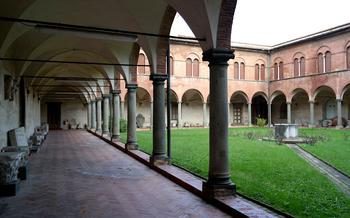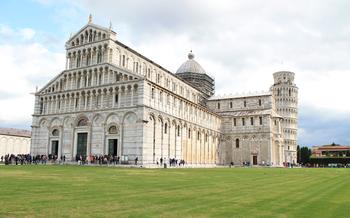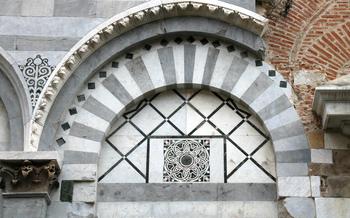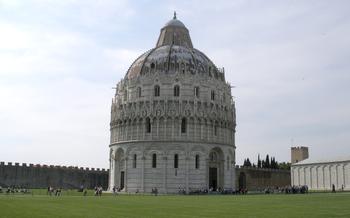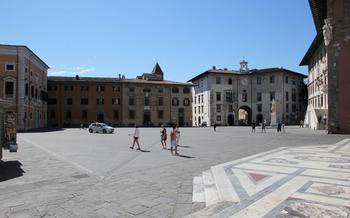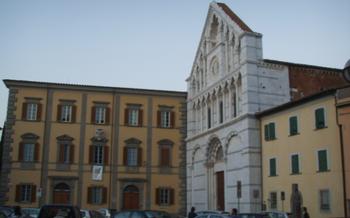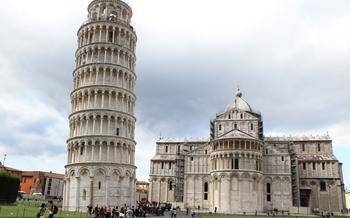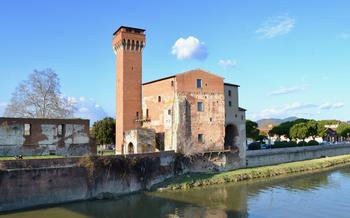
Chiesa di San Frediano
- Chiesa di San Frediano: A Masterpiece of Medieval Architecture
- History
- Architecture
- Interior
- Frescoes: A Vivid Tapestry of Biblical Narratives
- Pisan Style: A Blend of Romanesque and Gothic
- San Frediano's Square: A Vibrant Gathering Place
- Leaning Bell Tower
- Restoration
- Historical Significance
- Visiting the Church
- Local Traditions
- Hidden Gems
- Photography Tips
- Insider Tip: Unveiling the Church's Secrets Through a Guided Tour
Chiesa di San Frediano: A Masterpiece of Medieval Architecture
In the heart of Pisa, Italy, stands the Chiesa di San Frediano, a testament to the city's rich history and architectural prowess. This magnificent medieval church, dating back to the 11th century, is a captivating blend of Romanesque and Pisan styles, renowned for its intricate carvings, stunning frescoes, and a leaning bell tower that adds to its unique charm. Its dedication to Saint Frediano, a 6th-century bishop of Lucca, further enhances its spiritual significance, making it a must-visit destination for pilgrims and art enthusiasts alike. Strategically located near the River Arno, the Chiesa di San Frediano has served as a vital spiritual and social center for the surrounding community for centuries, witnessing countless events that have shaped the city's identity.
History
The Chiesa di San Frediano boasts a captivating history, dating back to the 11th century. Originally constructed in the Romanesque style, the church underwent a significant reconstruction in the 12th century following a devastating fire. This reconstruction resulted in the incorporation of Gothic elements, blending the two architectural styles to create a unique and harmonious appearance.
The church is dedicated to Saint Frediano, a 6th-century bishop of Lucca, who is revered for his devotion to the poor and his miraculous powers. According to legend, Saint Frediano was instrumental in bringing Christianity to the region and is credited with performing numerous miracles, including healing the sick and raising the dead. His relics are enshrined within the church, attracting pilgrims from all over Tuscany and beyond.
Strategically situated near the River Arno, the Chiesa di San Frediano served as a vital spiritual and social center for the surrounding community. Its proximity to the river facilitated trade and commerce, contributing to the church's importance as a gathering place for both religious and secular matters. Throughout the centuries, the church has witnessed pivotal events in Pisa's history, serving as a backdrop to religious ceremonies, political gatherings, and cultural celebrations.
Architecture
The Chiesa di San Frediano boasts a captivating Romanesque-Pisan architectural style, characterized by its distinctive facade adorned with white and green marble. The intricately carved facade features a series of biblical scenes and figures, adding to its visual appeal. One of the church's most striking features is its impressive bell tower, known as the "Torre Pendente di San Frediano." This leaning bell tower, similar to the more famous Leaning Tower of Pisa, adds to the church's unique character. The slight inclination of the tower is attributed to the soft ground beneath the church's foundation.
Interior
The interior of the Chiesa di San Frediano is a testament to the grandeur and artistry of the Pisan Romanesque style. The spacious and luminous space features a Latin cross plan, with a central nave and two side aisles separated by rows of elegant columns and arches. The three apses, each adorned with beautiful frescoes and mosaics, are particularly noteworthy. The central apse features a majestic depiction of Christ in Majesty, surrounded by the symbols of the four evangelists, while the side apses depict scenes from the life of Saint Frediano and other saints. The walls and ceilings are further embellished with a rich tapestry of frescoes by renowned artists such as Cimabue and Taddeo Gaddi, depicting scenes from the Bible, the life of Christ, and the lives of various saints. These frescoes, with their vivid colors and intricate details, played a crucial role in educating the largely illiterate population of the time, bringing to life religious stories and teachings in a visually captivating manner.
Frescoes: A Vivid Tapestry of Biblical Narratives
The walls and ceilings of the Chiesa di San Frediano are adorned with a remarkable collection of frescoes, each a masterpiece of medieval art. Created by renowned artists such as Cimabue and Taddeo Gaddi, these frescoes bring to life biblical stories, the life of Christ, and the lives of various saints. The vibrant colors and intricate details of these paintings captivate visitors, offering a glimpse into the religious beliefs and artistic traditions of the time.
One of the most notable frescoes is Cimabue's "Madonna and Child with Angels," which depicts the Virgin Mary holding the infant Jesus in her arms, surrounded by a host of angels. The fresco's expressive figures and rich colors showcase Cimabue's mastery of the Byzantine style. Another highlight is Taddeo Gaddi's fresco cycle depicting scenes from the life of Saint Frediano, the church's patron saint. These frescoes narrate episodes from Frediano's life, including his ordination as bishop of Lucca and his miraculous healing of a blind man.
The frescoes in the Chiesa di San Frediano played a crucial role in educating the largely illiterate population of the time. They served as visual aids, illustrating religious stories and teachings in a way that everyone could understand. The vivid and emotive nature of these paintings helped to convey the messages of the Bible and the lives of the saints to the faithful, fostering a deeper connection with their faith.
Pisan Style: A Blend of Romanesque and Gothic
The Chiesa di San Frediano is a prime example of the unique Pisan style, which emerged in Pisa and the surrounding region during the Middle Ages. This distinctive architectural style blends elements of both Romanesque and Gothic architecture, creating a harmonious and visually appealing aesthetic.
One of the most striking features of the Pisan style is its extensive use of white and green marble. This combination creates a striking contrast that highlights the intricate carvings and sculptural details adorning the church's facade. The rounded arches, a characteristic feature of Gothic architecture, are another defining element of the Pisan style, adding a sense of lightness and elegance to the church's overall appearance.
The Pisan style is not exclusive to the Chiesa di San Frediano. Other notable examples of Pisan architecture can be found throughout Pisa and the surrounding region. The Piazza dei Miracoli, a UNESCO World Heritage Site, is home to several iconic Pisan buildings, including the Leaning Tower of Pisa and the Cathedral of Pisa. These architectural masterpieces showcase the skill and artistry of Pisan craftsmen and stand as testaments to the city's rich artistic heritage.
San Frediano's Square: A Vibrant Gathering Place
In front of the Chiesa di San Frediano lies the charming Piazza San Frediano, a vibrant gathering place for locals and tourists alike. This bustling square serves as the heart of the surrounding neighborhood, hosting a lively market every morning except Sunday, where vendors sell fresh produce, artisanal goods, and local delicacies. The market creates a vibrant atmosphere as locals haggle over prices and tourists soak in the authentic Italian experience.
Throughout the year, Piazza San Frediano transforms into a festive venue for various events and celebrations. During the summer months, the square comes alive with outdoor concerts, dance performances, and food festivals, attracting both locals and visitors who come to enjoy the lively ambiance and partake in the festivities. The square's central location makes it an ideal spot for these gatherings, creating a sense of community and bringing people together.
Surrounding the square are numerous cafes, restaurants, and shops, offering a delightful mix of culinary experiences and shopping opportunities. Visitors can savor traditional Tuscan cuisine at one of the many restaurants, indulge in delicious pastries at a local bakery, or shop for souvenirs and artisanal products at the charming boutiques. The square's lively atmosphere, combined with its array of amenities, makes it a perfect place to relax, soak in the local culture, and enjoy a taste of authentic Italian life.
Leaning Bell Tower
The Chiesa di San Frediano features a charming leaning bell tower, contributing to its unique character and overall allure. Like its more famous counterpart in the Piazza dei Miracoli, the bell tower of San Frediano gracefully defies gravity, leaning slightly to one side. This intriguing inclination is attributed to the soft ground beneath the church's foundation, causing the tower to gradually settle over time.
Despite its lean, the bell tower remains a sturdy and well-maintained structure, thanks to ongoing monitoring and maintenance efforts. Visitors can safely climb the tower's narrow staircase to reach the top, where they are rewarded with breathtaking panoramic views of Pisa and the surrounding countryside. From this vantage point, one can fully appreciate the harmonious blend of architectural styles that define the city's skyline, with the iconic Leaning Tower of Pisa standing tall in the distance.
The leaning bell tower of San Frediano serves as a testament to the resilience and ingenuity of Pisa's medieval builders, who skillfully navigated challenging geological conditions to create a lasting architectural masterpiece. Today, this charmingly tilted tower stands as a beloved symbol of the city's rich history and architectural heritage.
Restoration
Throughout its history, the Chiesa di San Frediano has undergone several significant restoration projects, with the most extensive renovation taking place in the 19th century. This comprehensive restoration aimed to preserve the church's architectural integrity and artistic treasures while addressing structural issues and conserving the original materials.
During this period, meticulous efforts were made to repair damaged elements, reinforce weakened structures, and clean and restore the church's stunning frescoes and artwork. Craftsmen and conservators worked tirelessly to restore the building to its former glory, ensuring that future generations could appreciate its beauty and historical significance.
One of the key challenges faced during the restoration process was stabilizing and repairing the church's bell tower, which had developed a significant lean due to the soft ground beneath the foundation. Engineers and architects employed innovative techniques to reinforce the tower's structure and prevent further movement, ensuring its longevity and safeguarding this iconic landmark.
Thanks to the dedication and expertise of skilled artisans and conservators, the Chiesa di San Frediano has been restored to its former splendor, allowing visitors to experience the church's architectural masterpiece and its rich artistic heritage in its best possible condition.
Historical Significance
The Chiesa di San Frediano holds immense historical significance, standing as a testament to Pisa's rich past and its pivotal role in shaping the city's religious and cultural identity. Its construction in the 11th century reflects the growing importance of Pisa as a maritime republic and its close ties to the Church. Throughout the centuries, the church has witnessed significant historical events, serving as a gathering place for religious ceremonies, civic celebrations, and political meetings.
Its dedication to Saint Frediano, a 6th-century bishop of Lucca, further emphasizes the church's deep-rooted connection to the region's religious heritage. The church's strategic location near the River Arno, a vital trade route, contributed to its prominence as a spiritual and social center for the surrounding community. Today, the Chiesa di San Frediano stands as a protected monument, recognized for its exceptional cultural value. Its inclusion on the UNESCO World Heritage List as part of the "Piazza del Duomo, Pisa" site further underscores its global significance.
Visiting the Church
Visiting the Chiesa di San Frediano is a must for anyone interested in art, history, or architecture. The church is open to the public daily, with varying hours depending on the time of year. Admission is free, making it an accessible and affordable attraction for visitors. Guided tours are available for those who want to learn more about the church's history and significance. The church is conveniently located in the heart of Pisa, just a short walk from the Piazza dei Miracoli and the Leaning Tower of Pisa. This proximity allows visitors to easily explore multiple sites in one visit, creating a comprehensive and immersive experience of Pisa's rich historical and cultural heritage. To avoid crowds and capture the best lighting for photography, it is recommended to visit the church early in the morning or late in the afternoon. Visitors should allocate at least an hour to fully appreciate the church's interior and exterior, including its intricate carvings, frescoes, and architectural details.
Local Traditions
The Chiesa di San Frediano is deeply ingrained in the cultural fabric of Pisa and holds great significance for the local community. Throughout the year, the church plays host to various religious festivals and processions that draw both locals and visitors alike. These events showcase the city's rich heritage and provide a glimpse into its centuries-old traditions.
One of the most notable celebrations is the annual feast of Saint Frediano, the church's patron saint, which takes place on March 18th. During this festival, the church is adorned with colorful decorations, and a solemn procession carrying the statue of Saint Frediano winds its way through the streets of Pisa. Devotees gather to pay homage to the saint and seek his blessings.
Another cherished tradition is the "Luminara di San Ranieri," which illuminates the city with thousands of candles on June 16th, the eve of the feast of Pisa's patron saint, San Ranieri. The church's facade is beautifully lit up, creating a magical ambiance that attracts visitors from far and wide.
These traditions are a testament to the enduring faith and devotion of the Pisan people. By participating in or simply observing these events, visitors can gain a deeper understanding of the city's cultural heritage and the deep connection between the church and the community it serves.
Hidden Gems
Beyond its well-known frescoes and architectural features, the Chiesa di San Frediano holds hidden gems that often go unnoticed by visitors. One such gem is a small, unassuming chapel located to the right of the main altar. This chapel, dedicated to the Madonna della Neve, houses a beautiful 14th-century fresco depicting the Virgin Mary holding the infant Jesus. The fresco is remarkably well-preserved and offers a glimpse into the artistic style of the period.
Another hidden gem is a series of secret passages that run beneath the church. These passages were once used by monks to move around the monastery without being seen by the public. Today, visitors can explore these passages on guided tours, gaining a unique perspective on the church's history and architecture.
Finally, take some time to explore the surrounding neighborhood of San Frediano. This vibrant area is home to charming streets, hidden piazzas, and traditional Italian restaurants. Be sure to visit the nearby Piazza del Carmine, where you'll find the Chiesa di Santa Maria del Carmine, another beautiful example of Pisan Romanesque architecture.
Photography Tips
The Chiesa di San Frediano offers a wealth of photographic opportunities, both inside and out. To capture the church's essence, consider the following tips:
-
Exterior: Position yourself in front of the church to capture its impressive facade. Use a wide-angle lens to include the entire structure and the surrounding Piazza San Frediano. Experiment with different angles to create dynamic compositions.
-
Interior: The church's interior is a photographer's paradise. To showcase its spaciousness, use a wide-angle lens and position yourself near the entrance. For close-ups of the frescoes and artwork, use a telephoto lens to isolate and magnify the details.
-
Lighting: The best time to photograph the church is during the "golden hour," shortly after sunrise or before sunset. The warm, diffused light during these times enhances the church's colors and textures.
-
Composition: Pay attention to the composition of your shots. Consider leading lines, such as the columns or arches, to draw the viewer's eye into the image. Experiment with different perspectives, such as shooting from a low angle to emphasize the church's height.
-
Details: Don't overlook the intricate details that adorn the church. Zoom in on the carvings, sculptures, and frescoes to capture their artistry and symbolism. These details often tell stories and add depth to your photographs.
Insider Tip: Unveiling the Church's Secrets Through a Guided Tour
To truly delve into the history and significance of the Chiesa di San Frediano, I highly recommend embarking on a guided tour. These tours, often led by passionate local experts, offer a unique opportunity to uncover the church's hidden secrets and stories that may otherwise go unnoticed. Learn about the symbolism behind the intricate carvings, the techniques used to create the stunning frescoes, and the fascinating lives of the people who built and adorned this sacred space. Guided tours allow you to ask questions, gain insights, and appreciate the church's beauty and history on a deeper level. Remember to book your tour in advance to secure your spot and make the most of this enriching experience.
